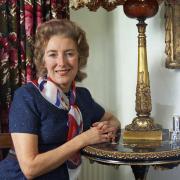She was born in Oxford, but was very much of Essex. Dorothy L. Sayers was a scholar, playwright, poet, editor, essayist, translator, lecturer, theologian, churchwarden, critic, and writer of detective stories, perhaps the most esteemed exponent of this genre since Sir Arthur Conan Doyle launched the career of ‘Sherlock Holmes’. Her novels were laced with ‘taste and style unequalled at the time when they were written’.
Dorothy Leigh Sayers was born on 13th June 1893, the only child of a reverend, Henry Sayers, and his spouse, Helen (‘Nell’) née Leigh. Dorothy’s inclusion of the middle ‘L’ in her author’s nom-de-plume was her homage to her mother and family, who were descended from landed gentry. Maybe this gave her the inspiration to concoct stories of murder among the well-to-do.

Dorothy was of Anglo-Irish descent, a vicar’s daughter brought up in the rectory in Bluntisham, close to March (Cambs) from the age of four. Before her family moved to East Anglia they’d lived in Oxford where Dorothy’s father was chaplain of Christ Church, and head of Christ Church Cathedral School (she was born in the headmaster’s house). Sayers later studied at Oxford’s Somerville College, from where she’d graduate in 1915 with first class honours in medieval French, one of the first women graduating from university. After graduating, one of Sayers’ first jobs was in Oxford’s famed Blackwell’s bookshop. She was also an advertising copywriter (1922-29), concocting the slogan ‘Guinness is good for you’, although her years as a ‘wage slave’ would be gratifyingly few once her career as an authoress took off. Her first novel, ‘Whose Body?’ was published in 1923, introducing her own gentlemanly sleuth, the aristocratic, urbane ‘Lord Peter Wimsey’. There’d be another ten Wimsey novels up to 1939 plus short stories.

Dorothy married Scottish journalist and highbrow thinker Oswald ‘Atherton’ Fleming (1881-1950) in 1926. She’d have one child, but not from her marriage. John Anthony Fleming was born in 1924, the son of an unemployed car salesman, Bill White. Although married, Dorothy continued to be known as ‘Dorothy L. Sayers’ (why change a winning formula?) and the Fleming/Sayers couple moved to mid-Essex in 1929, setting up home at 22, Newland Street, Witham, which became the authoress’s bolthole for the remaining 28 years or so of her life. In a period of rapid comings and goings she lost her father the year before (1928) which is when she moved her mum into a cottage in Witham, but she only lived into the following year which is when Dorothy bought the house next door, converting two dwellings into one. This is where Sayers wrote some of her best work, the relative quietness enabling her to concentrate.

Sayers continued with ‘Clouds of Witness’ (1926), introducing a female lead in 1930 when ‘Harriet Vane’ debuted in ‘Strong Poison’, who immediately became the object of Wimsey’s ardour. There were accurately observed tales such as ‘Murder Must Advertise’ (1933) and ‘The Nine Tailors’ (1934) showing she was as much at home delving into the world of advertising as she was using bellringing as a background to a story. Campanology and homicide became bedfellows in ‘The Nine Tailors’ with Sayers’ ‘Fenchurch St Paul’ being modelled on St Wendreda’s in March. She became an East Anglian gal but one who migrated south to Essex.

By the time she published ‘Gaudy Night’ (1935) and ‘Busman’s Honeymoon’ (1937) Sayers was moving on. ‘Gaudy Night’, finally saw Harriet Vane succumb to Wimsey’s persistence by accepting a marriage proposal. It took five years and half-a-dozen novels to get there! ‘Busman’s Honeymoon’ meanwhile saw Wimsey arrive on the stage in 1936, the novel of the play published the following year. Another of her creations was the gloriously-named Montague Egg, another sleuth. A change of direction ensued from the mid-‘30s when Sayers wrote plays, mostly of a religious persuasion, before turning to translations. With financial security achieved, it was possible for Sayers to indulge her true interests. You feel Wimsey was a transient ‘pulp fiction’ character whose success gave Dorothy the opportunity for serious writing. She turned her back on him in the same way Conan Doyle tried to finish off ‘Sherlock Holmes’ so he could write historical romances.

Dorothy became a Christian apologist with successful plays ‘The Zeal of Thy House’ (1937) and ‘The Devil to Pay’ (1939). ‘The Mind of the Maker’ (1941) was a carefully reasoned essay, whilst ‘The Man Born to be King’ (1943), the story of the life of Christ, was broadcast on the radio, and provoked controversy. Her plays were performed in majestic settings, like cathedrals, or aired by the BBC. From the early-1940s, Dorothy reinvented herself again as she taught herself old-style Italian to translate the three books of Dante’s ‘Divine Comedy’ into English. She completed his famed ‘Inferno’ (1949), followed by ‘Purgatorio’ (1955). She was still working on ‘The Paradiso’ when she died. This showed the academic side of Sayers; the honoured graduate. She also used her old French to finish her translation of the ‘Song of Roland’.
Dorothy died at her Essex home on 17th December 1957 aged 64, half-a-dozen years after her husband, and is remembered with a plaque on her former home and a bronze statue in a small square opposite, across the road from today’s library which was a cinema in Dorothy’s day. The statue features a cat; Dorothy was fond of her felines. There’s also a road named after her. She’s recognised as one of the ‘Queens of Crime’ of the golden era of the genre, the 1920s and ‘30s, placed alongside that other doyen, Agatha Christie. Her own anthology of the detective story, ‘The Omnibus of Crime’, was published in 1929. She was of sufficient literary stature to number the likes of C.S. Lewis and T.S. Eliot among her mates and to have numerous biographies written about her. She delighted in good argument, kept her brain trim doing puzzles, and believed in the gospel of hard work, hence her saying: ‘The only Christian work is good work, well done’.



























